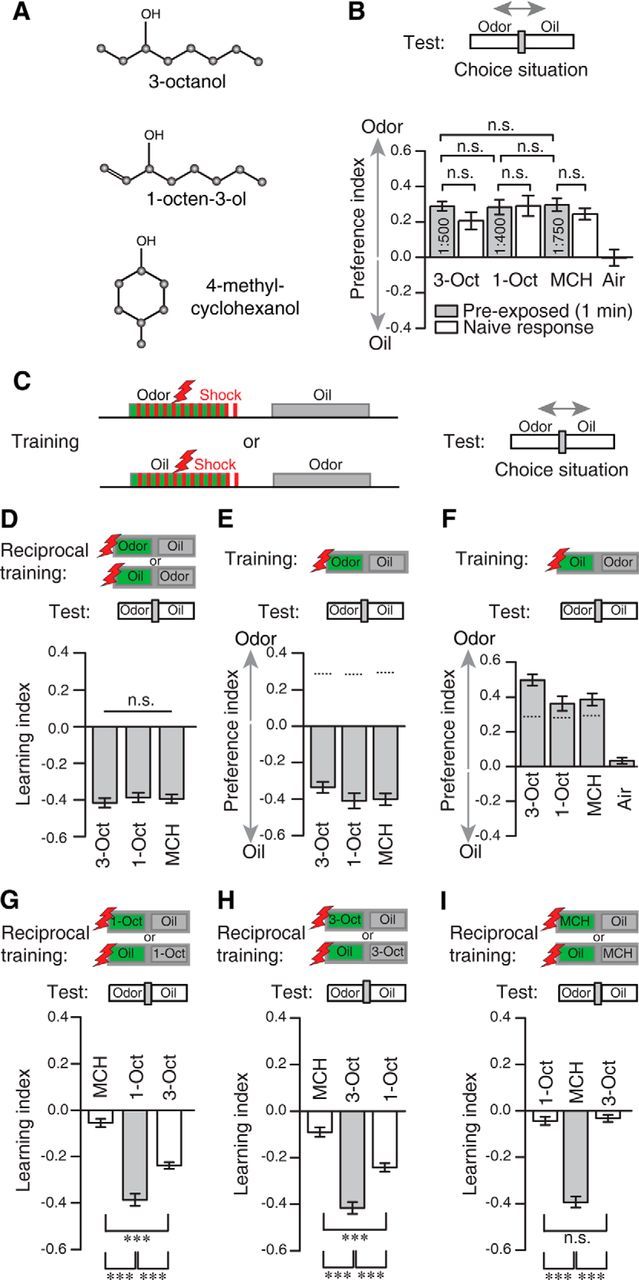Figure 1.

Generalization across similar odors. A, Chemical structures of the three odorants used: 3-Oct, 1-Oct, and MCH. B, Odor preference of flies for the odorants 3-Oct, 1-Oct, and MCH at the dilutions indicated within the bars in a T-maze choice situation against the diluent mineral oil (Oil). White bars represent the preferences of naive flies. Gray bars represent the responses of flies that were preexposed to the respective odor for 1 min. No significant differences between preexposed and naive animals (two-sample t test), and no differences between the three odors at the indicated concentrations were observed. n.s., Not significant (p > 0.05; one-way ANOVA). Bars indicate mean ± SEM; n = 16 for preexposed animals, n = 8 for naive animals. No preference for the diluent mineral oil was detected when tested against blank air. C, Schematic illustration of the absolute associative conditioning regimen. Green box represents odor or diluent (mineral oil) that is temporally paired with electric shocks (red boxes). Gray box represents odor or diluent stimulation without punishment. During the test, the trained flies were subjected to a choice situation between odor and mineral oil. D, Equal learnability of the three odors after absolute, reciprocal training. n.s., Not significant (p > 0.05; one-way ANOVA). Bars indicate mean ± SEM; n = 16 for each experiment. Either the odor or the diluent was temporally paired with electric shocks (gray boxes in the schematic illustrations). Negative learning indices indicate learned avoidance of the stimulus previously paired with the electric shocks. E, Preference indices of animals subjected to an odor simultaneously with the electric shocks and the diluent without electric shocks. For comparison, the dotted lines indicate odor preferences of untrained animals that have been preexposed to the odors as shown in B. The associative training caused an aversive behavior, indicated by negative preference indices. Bars indicate mean ± SEM; n = 16 for each experiment. F, Preference indices of animals that have received electric shock stimulation simultaneously with the presentation of the diluent, but not during odor presentation. The dotted lines indicate odor preferences of untrained animals that have been preexposed to the odors as shown in B. The training caused a slight increase in attractiveness compared with the naive preference, which is statistically significant only for 3-Oct (3-Oct: naive vs trained, p < 0.001, two-sample t test). Bars indicate mean ± SEM; n = 16 for each experiment. G–I, Absolute, reciprocal training of 1-Oct (G), 3-Oct (H), and MCH (I) against the diluent mineral oil and test for the avoidance of each odor. In all cases, flies strongly avoided the trained odor (gray bars). Generalization was observed if flies were trained with either 1-Oct or 3-Oct and tested for the respective similar odor, but not if they were tested for the dissimilar odor MCH (G, H). Flies did not generalize to 1-Oct or 3-Oct after training with MCH (I). n.s., Not significant (p > 0.05; one-way ANOVA with Bonferroni post hoc test). ***p < 0.001 (one-way ANOVA with Bonferroni post hoc test). n = 16 for each experiment. Bars indicate mean ± SEM.
